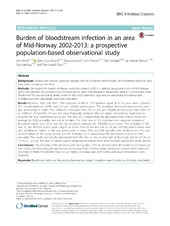| dc.contributor.author | Mehl, Arne | en_US |
| dc.contributor.author | Åsvold, Bjørn Olav | en_US |
| dc.contributor.author | Lydersen, Stian | en_US |
| dc.contributor.author | Paulsen, Julie | en_US |
| dc.contributor.author | Solligård, Erik | en_US |
| dc.contributor.author | Damås, Jan Kristian | en_US |
| dc.contributor.author | Harthug, Stig | en_US |
| dc.contributor.author | Edna, Tom-Harald | en_US |
| dc.date.accessioned | 2017-09-21T07:54:59Z | |
| dc.date.available | 2017-09-21T07:54:59Z | |
| dc.date.issued | 2017-03-11 | |
| dc.Published | Mehl A, Åsvold BO, Lydersen S, Paulsen J, Solligård E, Damås JK, Harthug S, Edna T-H. Burden of bloodstream infection in an area of Mid-Norway 2002-2013: A prospective population-based observational study. BMC Infectious Diseases. 2017;17:205 | eng |
| dc.identifier.issn | 1471-2334 | |
| dc.identifier.uri | https://hdl.handle.net/1956/16697 | |
| dc.description.abstract | Background: Studies from several countries indicate that the incidence and mortality of bloodstream infection (BSI) have been increasing over time. Methods: We studied the burden of disease and death related to BSI in a defined geographical area of Mid-Norway, where BSI episodes were prospectively recorded by the same microbiological department during 12 consecutive years. Death from BSI was defined as death within 30 days of BSI detection. Age and sex standardized incidence and mortality rates and case fatality rates were calculated. Results: Between 2002 and 2013, 1995 episodes of BSI in 1719 patients aged 16 to 99 years were included. The overall incidence of BSI was 215 per 100,000 person-years. The incidence increased exponentially with age, particularly in males. The incidence increased from 205 to 223 per 100,000 person-years from 2002–07 to 2008–13. Escherichia coli was the most frequently isolated infective agent, followed by Streptococcus pneumoniae and Staphylococcus aureus. The rate of S. pneumoniae BSI decreased over time in males (on average by 9.2% annually), but not in females. The total rate of BSI microbes with acquired resistance increased slightly over time, but did not exceed 2 episodes per 100,000 person-years. The mortality of BSI was 32 per 100,000 person-years, higher in males than in females (36 vs. 28 per 100,000 person-years) and was significantly higher in old age, particularly in males. The total BSI mortality was similar in the first and second halves of the study period, but the mortality of S. pneumoniae BSI decreased in males (15.0% annually). The crude case fatality decreased from the first to the second half of the study period (17.2% to 13.1%; p = 0.014). The rate of blood culture sampling increased more than twofold during the study period. Conclusions: The mortality of BSI remained stable during 2002–2013. At the same time, BSI incidence increased and case fatality rate decreased, perhaps because an increased rate of blood culture sampling may have led to improved detection of milder BSI episodes. Very low, yet slightly increasing rates of microbes with acquired resistance were observed. | en_US |
| dc.language.iso | eng | eng |
| dc.publisher | BioMed Central | eng |
| dc.rights | Attribution CC BY | eng |
| dc.rights.uri | http://creativecommons.org/licenses/by/4.0 | eng |
| dc.subject | Bloodstream infection | eng |
| dc.subject | Bacteremia | eng |
| dc.subject | Bacteraemia | eng |
| dc.subject | Sepsis | eng |
| dc.subject | Population-based | eng |
| dc.subject | Incidence | eng |
| dc.subject | Mortality | eng |
| dc.subject | Case fatality | eng |
| dc.title | Burden of bloodstream infection in an area of Mid-Norway 2002-2013: A prospective population-based observational study | en_US |
| dc.type | Peer reviewed | |
| dc.type | Journal article | |
| dc.date.updated | 2017-08-30T12:20:06Z | |
| dc.description.version | publishedVersion | en_US |
| dc.rights.holder | Copyright 2017 The Author(s) | |
| dc.identifier.doi | https://doi.org/10.1186/s12879-017-2291-2 | |
| dc.identifier.cristin | 1468802 | |
| dc.source.journal | BMC Infectious Diseases | |
| dc.relation.project | Norges forskningsråd: 223255 | |

